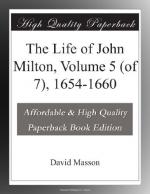No sooner was the House constituted, with about 320 members present out of the total 460, than it proposed for its first business what was called “The Matter of the Government”; by which was meant a review of that document of forty-two Articles, called the Government of the Commonwealth, which was the constitutional basis of the Protectorate. On Thursday, Sept. 7, accordingly, they addressed themselves to the vital question of the whole document as propounded in the first of the Articles. “Whether the House shall approve that the Government shall be in one Single Person and a Parliament”: such was the debate that day in Grand Committee, after a division on the previous question whether they should go into Committee. On this previous question 136 had voted No, with Sir Charles Wolseley and Mr. Strickland (two of the Council of State) for their tellers, but 141 had voted Yea, with Bradshaw and Colonel Birch for their tellers. In other words, it had been carried by a majority of five that it fell within the province of the House to determine whether the Single-Person element in the Government of the Commonwealth, already introduced somehow as a matter of fact, should be continued. On this subject the House debated through the rest of that sitting, and the whole of the next, and the next, and the next,—i.e. till Monday, Sept 11. Bradshaw, Hasilrig, and Scott took the lead for the Republicans, not that they hoped to unseat Cromwell, but that they wanted to assert the paramount authority of Parliament, and convert the existing Protectorship into a derivative from the House then sitting. Lawrence, Wolseley, Strickland, and others of the Council of State, describable as the ministerial members, maintained the existing constitution of the Protectorate, and pointed out the dangers that would arise from plucking up a good practical basis for mere reasons of theory. Matthew Hale interposed at last with a middle motion, substantially embodying the Republican view, but affirming the Protectorship at once, and reserving qualification. All in all, there was great excitement, much confusion, and an outbreak from some members of very violent language about Cromwell.[1]
[Footnote 1: Commons Journals of dates: Parl. Hist. III. 1445; Godwin, IV. 116-125.]
What might have been the issue had a vote come on can only be guessed. Things were not allowed to go that length. On Tuesday, Sept, 12, the members, going to the House, found the doors locked, soldiers in and around Westminster Hall, and a summons from the Lord Protector to meet him again in the Painted Chamber. Having assembled there, they listened to Cromwell’s “Third Speech.” It is one of the most powerful of all his speeches. It began with a long review of his life in general and the steps by which he had recently been brought to the Protectorship. It proceeded then to a recitation of what he called “the witnesses” to his Government, or proofs of its validity—the




